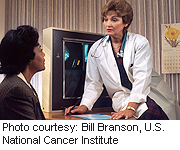
TUESDAY, Oct. 7, 2014 (HealthDay News) — Researchers have found it’s possible to detect ovarian cancer gene mutations in vaginal fluid samples — a finding they hope is a step toward an effective screening test for the disease.
In a pilot study, researchers were able to detect tumor DNA in tampons from several women with advanced ovarian cancer. It’s a “proof of principle” that genetic evidence of the cancer can be uncovered in vaginal samples, they noted.
Ovarian cancer is highly treatable if it’s caught in the early stages, but most women are diagnosed only after the cancer has advanced. Because of that, only 44 percent of women with the disease survive for five years, according to the American Cancer Society.
“Ovarian cancer does cause some symptoms early on. The problem is, they’re non-specific,” said Dr. Charles Landen, the senior researcher on the new study, which appears in the November issue of Obstetrics & Gynecology.
A woman might have abdominal bloating or urinary symptoms, for instance — but those problems are much more likely to have causes other than ovarian cancer. And right now, there is no effective screening test for the disease.
“Ovarian cancer is relatively uncommon,” said Landen, a gynecologic cancer specialist at the University of Virginia in Charlottesville. “So any screening test would have to be very good.”
That is, it would have to be sensitive enough to reliably catch early ovarian cancer, but have a low risk of false alarms — and unnecessary invasive procedures.
“We have to be sure we’re not going to harm more women than we help,” said Dr. David Mutch, a professor of obstetrics and gynecology at Washington University in St. Louis.
The new findings lay the groundwork for future research, according to Mutch, who wrote an editorial published with the study.
“Will this become a screening test?” Mutch said. “It shows promise. But we still need to go through the necessary steps to validate it.”
In the United States, about 22,000 women will be diagnosed with ovarian cancer this year, and almost 14,300 will die, according to the American Cancer Society. The risk goes up with age (most cases develop after menopause), and women with a family history of ovarian cancer are at higher-than-average risk.
Researchers have long sought a good screening test for the disease; it’s considered the “holy grail” in battling gynecologic cancers, Mutch said.
But only recently has there been the technology capable of detecting tiny bits of tumor DNA in vaginal fluid. To put it to the test, Landen’s team analyzed fluid samples — obtained with tampons — from eight women with advanced ovarian cancer.
Three of those women had had their fallopian tubes “tied,” and there was no evidence of tumor DNA in their vaginal fluid. But of the five women with intact fallopian tubes, three had tumor DNA in their samples.
“That’s a 60 percent rate, and that’s not good enough,” Landen said. So one of the next steps, he noted, is to try to refine the test to make it more sensitive.
The researchers also plan to study women with early stage ovarian cancer, to see if DNA mutations are detectable at that point. That will be key for the test to be used for screening or early diagnosis, Landen said.
Since ovarian cancer is fairly rare, Landen said any screening test would have to be “outstanding” for it to be widely used — in the way mammography is used to screen for breast cancer, for example.
But, Landen noted, screening tests could be targeted to certain women, such as those who carry BRCA gene mutations, which confer high risks of breast and ovarian cancers.
Besides the questions about effectiveness, the technology used in this study is still too expensive for widespread use, Landen pointed out. “But with time,” he said, “we expect the costs will drop substantially.”
More information
The American Cancer Society has more on ovarian cancer.
Copyright © 2025 HealthDay. All rights reserved.

